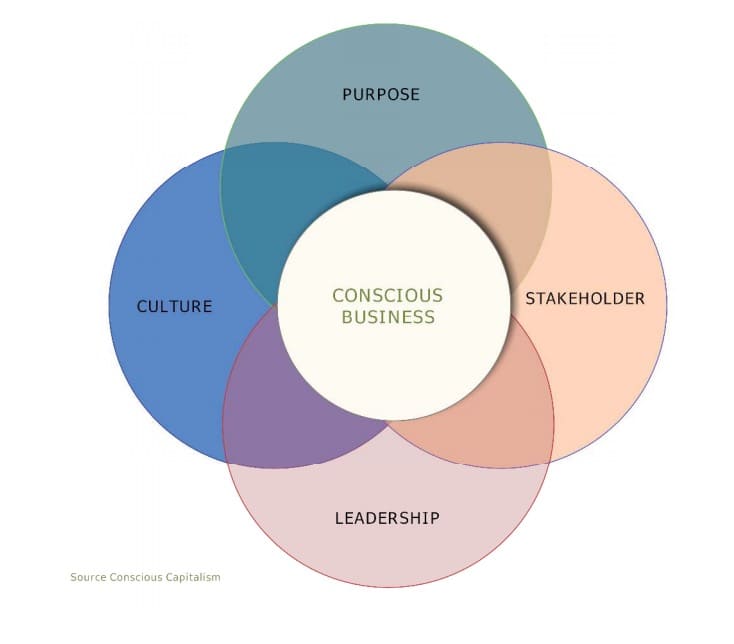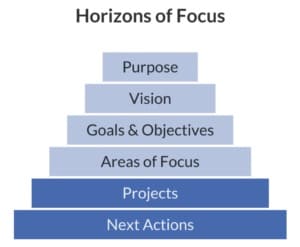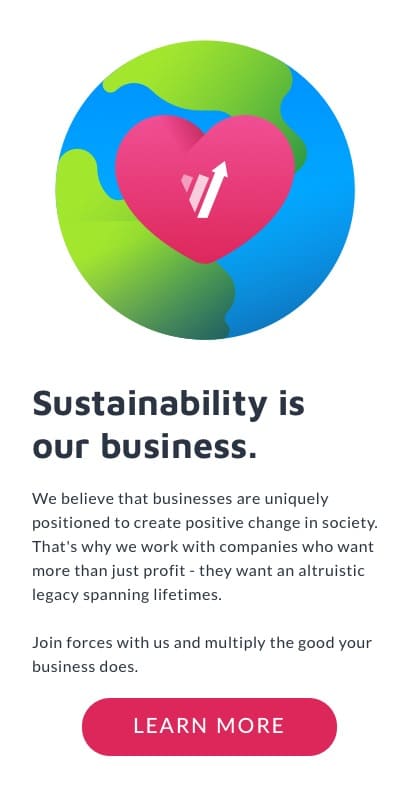Nothing Working For Your Business? Your Company Is Going Through an Existential Crisis. Here’s How to Shake it Off.
This is the second blog in Convert’s sustainability series. Go check out the first installment about the Pandemic and the Role of the Retention Economy, if you haven’t already. In this installment, we are diving into the concept of Conscious Business, what it entails, and how it might just be the spark brands need to move out of their existential slump!
The way Brian Robertson, the founder of Holacracy, looks at a business is fascinating.
What is your company to you?
Labor of love?
Source of income?
Force of good?
The answers can span the spectrum – from altruistic to self-serving.
But you can’t deny the fact that your business:
- Evolves with time,
- Thrives on creativity,
- Can be put out of the market by a competitor,
- Seemingly takes on a life of its own after it’s been around for a while.
Your business and your brand mimic life. What you’ve created is alive.
And this living, expanding organism can go through an existential crisis. Just as its human counterparts do. The difference is, most founders and teams can’t recognize the symptoms of this crisis and don’t have the right questions to diagnose the problem.
In my line of work, I have helped plenty of companies flip the situation. In this blog, I’ll share my “aha” moments and findings for the time when absolutely nothing seems to “come together” for your business.
You Don’t Have a Brand Problem. You Have a Purpose Problem.
We all remember Pepsi’s million-dollar logo redesign. And the flak Arnell received for it.
That move was edgy. And may just have been the most well-executed example of guerilla marketing we’ve ever seen.
But if you wind the clock back to 1985, you’ll witness a true blue Cola rebrand fall flat on its face.
I am talking about the “New Coke” disaster. That time Coca Cola was so shaken by rogue Pepsi gobbling up market share that it decided to launch a product similar in taste and sugary appeal to its nemesis, Pepsi, while relegating the classic coke to the corner.
Based on market numbers and Pepsi’s audacious claim that blindfolded, more people prefer Pepsi to Coke, it seemed like the logical thing to do.
The plan backfired spectacularly. And Coca Cola learned the importance of its purpose, its reason for existing, and how consumer sentiments are irrationally impacted by how you make them feel.
Staunch Coca Cola supporters boycotted the new drink.
Yes, Pepsi was sugary. Yes, Pepsi was probably more interesting. But Pepsi was Pepsi, a different kettle of fish.
The ride-or-die buyers wanted Coke, the nostalgia associated with Coke. The promise of plenty and the ultimate American dream.
In short, they sought to refresh their mind, body, and spirit with the escape that a chilled bottle of Coca Cola promised. The idea that as long as a Coke was around, normalcy was one sip away. Everything that had catapulted Coke into being the national drink of the US after the turbulence of the World Wars and the Depression.
Why the story?
Because you, you don’t have a brand problem. You certainly don’t have a “marketing” problem. The fact that your business isn’t creating the impact you’ve always wanted it to is merely the symptom. What you do have is a purpose problem.
Your company is in the throes of an existential crisis.
It does not exist to pump out lead magnets, or a product, or even generate revenue. And it certainly does not exist to blindly copy competitors until the market gets so saturated that similar tools and services are collectively swept under the rug by customers desensitized to the bland messaging.
It exists to deliver a transformation. A clear “before and after” that promises a better way, a better life, and just feeling better.
The question then is, what can you do to get this clarion call of “better” to your ideal buyers? Want to take it up a notch? Don’t think of them as your buyers. Flip the mental switch and think of them as people with a problem… Folks you really want to help. Feel that pain. And then channel your purpose in practical ways to alleviate it.
Don’t start at the Archetype or with the logo. Doing the website before deep introspection is the recipe for disaster. Start with the purpose of your company.
A human being who is not clear on the WHY makes costly mistakes. A company that is not clear on its WHY stays stuck in ephemeral tactics, in leads that will never close, and in delivering an inconsistent experience to its buyers.
Such a business fails on both counts: the promise of the Experience Economy and the execution that’s measured by the Retention Economy.
Merging Profits with Purpose: Meet the Conscious Business.
When I tell my consulting clients, “You have to clarify your purpose before you can throw your MVP out there…”, they are resistant to the idea.
They want to test out the messaging. They want to start building lists. And they want to see their potential turned into reality.
But in my experience, true strategy emerges only when the foundational trio of Purpose-Vision-Mission is found, understood, and propagated through the organization.
This is why the concept of a Conscious Business is intriguing. It makes being “conscious” or “purpose-driven”, being aware of how a business is impacting the world, a non-negotiable aspect of its existence.
Conscious Business sounds like an oxymoron. But it is a clean and simple bridge between the positive change you want to see in the world and the rigors and processes of a business necessary to get the funds that let you live your purpose.
Cause at the end of the day, unless you are a non-profit, you are for-profit. And profits matter.
Convert has been around for 10 years. It has been a Conscious Business for 5. As someone who is part of the team, I can vouch that the culture at Convert is the best thing about Convert.
A large part of that unique culture can be traced to its Conscious Business bent!
So when I had the opportunity to interview Morgan Legge, my peer and the person who has shaped founder Dennis van der Heijden’s vision of operating in the Holacratic-Conscious Business space, I didn’t hesitate.
After all, culture eats strategy for breakfast, right?
Morgan talked about how Convert came to be a Conscious Business, how this sentiment has influenced every aspect of the company… especially the culture, what you can do to embrace the path, and the halo effect of being Conscious on our brand and our market presence.
A Baby Changed Convert’s Course
Our co-founder Dennis van der Heijden’s baby!
When little Amy was born, Dennis was mulling his contribution to the world. To be more specific, he wanted his daughter to grow up in a better world.
A tall task…
But every sweeping change must start small and he decided to focus on the goal of treating his employees as well as his children.
This triggered a quest to empower them, thanks to which Holacracy was introduced at Convert.
And finally, when the team was the right mix of people passionate about optimizing each interaction with the world, injecting a bit of goodness through every action and word, Convert fully aligned its business structure with the tenets of consciousness.
How Convert became a Conscious Business
3 Steps to Shake Off Existential Crisis & Let Purpose Lead Your Company to Success (+ How Convert Does It)
Before diving into the steps, a caveat.
You absolutely don’t have to call yourself a Conscious Business to live your purpose. You don’t have to change your organizational structure to accommodate Holacracy.
Being a Conscious Business serves Convert because its purpose is aligned with climate positivity and being a force of good in the world.
Holacracy is something Convert embraced because it explicitly states that the PURPOSE of the company is the “boss”. Not the managers! Not the C-suite.
Don’t get caught up in the details of how other companies are weaving their purpose into their operations! It’s enough to understand that lackluster numbers can’t be fixed with TikTok or Clubhouse or product-led anything, in isolation.
Channels and tactics come alive when they have a guiding principle (a purpose) to funnel their growth and make the messaging relevant and contextual for ideal consumers. That’s the state you need to aim for to break your performance slump.
#1. Clarify That the Purpose is Not the Product
The product or the software you sell isn’t your purpose. It never was.
Yet, most companies start and end in the product/service loop.
Why is this distinction so important?
When you don’t see how your product fits in the bigger picture, the grander scheme of things, for your own business, how can you expect to ever elevate your messaging to the level where buyers bombarded with similar offers are compelled to consider your company and brand as a potential solution?
Understand that an obsessive focus on features and benefits does a disservice to your offering and your brand.
They have their place on a landing page.
But if people are already on your page of their own volition and intention (which is what drives meaningful conversions, especially for products with longer buying cycles), then you have managed to get over the most difficult bump — getting their attention in a positive and significant way.
Wake up to the fact that features and benefits alone can’t generate or capture demand. They are tools to drive conversions, not the best tools to drive awareness and interest.
Look at this UberMinds ad as an example.
Seriously, check it out.
Do you believe for a second that the creative team at Uber got this angle by thinking inside the box? By going over its well-worn roster of features, benefits, and user requests? Yes, some voice of customer research certainly fueled its creation.
But here’s why Uber exists: We ignite opportunity by setting the world in motion.
It doesn’t exist to offer reliable pay-per-ride transportation. It exists to mobilize people and opportunities.
The social campaign of UberMinds is a stellar example of that. It connects folks who are struggling in the aftermath of the pandemic with the help they need the most, a sympathetic ear. Yet the literal vehicle of delivery is Uber’s fleet.
Calm jumping on to pay the fines of tennis players wishing to duck out of post-match interviews is a great move. But Calm is an app that deals with anxiety. It’s expected. What Calm did is (almost) newsjacking.
What Uber did is purpose-driven strategy at its best.
You might face a lot of resistance when you try to shed light on why the PURPOSE of a business matters. And how it can dictate strategy, its execution, and help team members see opportunities where nothing conspicuous exists.
But the mere exercise of breaking free from the cubicles of Marketing, Product, Sales, Service, HR to look at something greater starts to nudge ideas — crazy ideas, innovative ideas, ideas that a marketing professor would squash with the lift of an eyebrow. But ideas that are aligned with what people actually need in the now and which can be served with your infrastructure!
Messaging that derives from purpose will resonate.
Because it tells a story of change. It births creative projects and initiatives that may not move the needle on leads and MQLs through direct attribution, but which earn media and mind-share, two of the most valuable channels of revenue available to a business today.
Most importantly, living your purpose with your product as the delivery mechanism helps your brand seamlessly insert itself into the setting where buyers are already living their lives. No one wants to be jolted out of the flow of existence to check salesy messages! If it seems like cold PPC ads are working for “other businesses”, it is because the paid ads are in context and on point, part of a larger purpose-driven strategy. They are serving prospect needs.
But no one ever tells you that!
Returning to the example of Convert, its purpose is to Create Great Experiences – For Now & Future Generations. The “experiences” bit is a hat tip in the direction of Convert Experiences, our app. But the purpose stands on its own.
It tells our team every day that we don’t exist to create A/B testing software. We exist to empower people (and the world at large) with everything they need to live, do, be better. And we execute on this purpose in a way that’s sustainable for the long term.
“We provide sustainability and trust in all what we do, from increasing value for our stakeholders and clients to expanded opportunities for development and career growth for our team and improving the local and global environment by becoming carbon neutral” – Dennis van der Heijden, CEO of Convert
#2. Distill the Purpose into Strategy with Vision & Mission
So what is the product?
Where does it fit in?
We won’t be throwing your product/service focus out the door.
We will demote it a few levels on the Horizons of Focus though.
Getting Things Done® offers a way to sort everything that’s going on around you into discrete levels of “focus”. The higher the level, the lower the impact of minutiae. In the higher levels, you contemplate and ideate. In the lower levels, you pay attention to details and execute.
Where your product focus starts to make sense is the level labeled “Vision”. It’s not absolutely necessary to weave your product in, but most companies do that.
Look at Microsoft’s founding Vision – A computer on every desk and in every home.
Think of this Vision as the best case execution of your highest aspiration for your product and your company. It goes beyond a 5-year plan. A big-hairy-audacious goal that’s in keeping with the purpose but exciting enough to challenge and inspire relatively shorter-term results.
The Vision statement gives the folks who work on your marketing and your product a guiding principle to follow.
The purpose brings people together.
The Vision is the destination that brings disparate departments with their specific KPIs and processes together. The Vision is what possibly spawns your North Star Metric.
Your Vision and your mission together shape your growth strategy.
On that note, let’s talk about your mission. The mission statement clarifies how you’ll use your product to achieve your vision and realize your purpose for existing.
A disclaimer is needed here. Sometimes, Vision and mission statements exist as one. Sometimes the Vision statement takes the place of purpose.
Don’t get thrown off by the names and the structure.
Simply ensure that you:
- Know why you exist (and it’s not to sell your product),
- Know what the world will look like if you reach your biggest goal (traditionally structured as the Vision statement),
- Know how you will fund your vision and purpose (which is through your mission and your product/service).
STRATEGY = PROBLEM (PURPOSE) + GUIDING PRINCIPLE (VISION) + ACTIONS (MISSION)
The trio of Why, What, How we went through maps really well to each component of the Strategy equation.
Here at Convert, the tenets of Conscious Business replace the conventional Vision statement. But we do have a big-hairy-audacious goal to hit in the near future.
We’ve allocated a portion of our MRR to offset carbon emissions. The tie is crucial.
Because our MRR is the result of us selling Convert Experiences. Thus our revenue feeds our end goal and sustains our Conscious Business operations, allowing us to bring who we are to what we do.
This isn’t restricted to financial implications. Morgan also shared how all circles (what departments are called in Holacracy) at Convert — sales, ops, marketing — chip away at their own relevant goals, always returning to the guiding principle of Conscious Business to ideate and execute.
How being a Conscious Business impacts day-to-day operations at Convert
#3. Market Human-to-Human (H2H)
Concepts like B2B and B2C are due for a revamp.
Especially in the context of Marketing.
You’ve probably been looking at Marketing through the lens of your vanity metrics and your funnel. How has that worked out for you so far?
Flip your mindset.
SEO, growth hacking, Account-Based Marketing – you will come across new and exciting things on the daily. It’s going to get a lot more crowded. An obsession with the latest and the loudest around how you insert yourself into the lives of your buyers results in two things:
- It spreads you out too thin. Obvious and a lot has been written about tactic fatigue.
- It puts process over outcome.
The outcome is – you want to educate your potential buyers because they are in pain and probably don’t know about the possible solutions. One of the ways in which you can do so is through Search Engine Optimization (SEO) which gives your content added visibility. But at what point did we go from writing to achieve that outcome to writing for search engines?
Don’t market in alignment with trends. Market to people. Because you have a purpose to serve. “Burdened with glorious purpose” you will come from a place of authenticity.
It is this authenticity that is the bedrock of human-to-human marketing.
And guess what… H2H is NEVER going out of style. You master this and you are set.
In fact, you can personally call me up and demand damages if Human to Human marketing goes out of style. The guarantee stands until the next robot uprising.
In H2H marketing you:
- Create a product to serve a purpose or assist a (needed) transformation. Not to mindlessly print money.
- Become friends with the people who crave this transformation. Understand what pains them, what makes them buy, and what the cost of inaction is.
Don’t call them a FOCUS group. Don’t try to define how they buy with the rigid confines of your funnel. They don’t give a damn.
People buy from friends! Not random strangers. And if you want them to buy from you, really caring about how they consume content, what they view as alternatives to your service/product, and how they wish to feel after they invest the money will put you MILES ahead of your competition. Even if the competition has raised a gazillion dollars in series Z funding. - Build a plan of action based on how well you know your friends. This consists of the channels, the tactics, the processes that make the most sense. You don’t set out to growth hack. But if you stumble upon an opportunity that seems like the perfect slam dunk, you take it. And the numbers make it look like a growth hack.
Hire specialists who know the channels and tactics that show initial promise.
Try things no one else in your space is doing, because it makes sense when considered through the filter of your purpose/vision/mission.
Don’t be blinded by gaps in attribution and vanity leads. Or metrics that are at best indicators of what you think is effective. And in most cases certainly NOT the actual scenario.
Say No… to everything that does not align with this raw and human-centric approach.
When Convert made the shift to being a Conscious Business, serendipitous connections happened. We started building a community of brands that feel the way we do.
How Convert built a community of Conscious Businesses
The fact that we are one of the most reliable A/B testing tools today isn’t just the offshoot of a product vision. It is the culmination of the journey Convert went on to understand itself and go above and beyond to leave a legacy of good!
It’s impossible to inspire excellence without spontaneous team buy-in and cohesive strategy.
The malaise of under-performance is a reflection of an existential crisis – in the company, in the people, and in the haphazard tactics that don’t make sense.
The answer as always is simple – Know Yourself First. The best stuff happens in that space.
Written By
Trina Moitra

Edited By
Carmen Apostu









